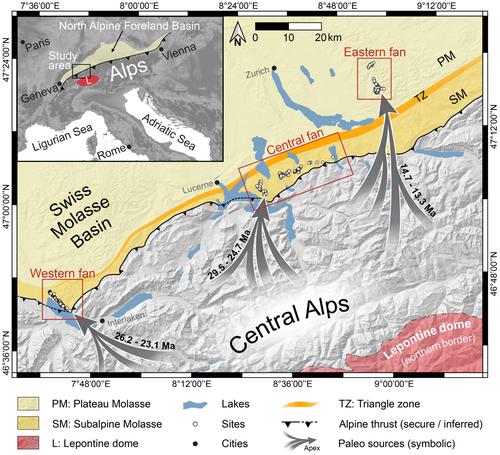当前位置:
X-MOL 学术
›
Basin Res.
›
论文详情
Our official English website, www.x-mol.net, welcomes your
feedback! (Note: you will need to create a separate account there.)
Quantification of sediment fluxes and intermittencies from Oligo–Miocene megafan deposits in the Swiss Molasse basin
Basin Research ( IF 2.8 ) Pub Date : 2024-04-24 , DOI: 10.1111/bre.12865 Philippos Garefalakis 1 , Ariel Henrique do Prado 1 , Alexander C. Whittaker 2 , David Mair 1 , Fritz Schlunegger 1
Basin Research ( IF 2.8 ) Pub Date : 2024-04-24 , DOI: 10.1111/bre.12865 Philippos Garefalakis 1 , Ariel Henrique do Prado 1 , Alexander C. Whittaker 2 , David Mair 1 , Fritz Schlunegger 1
Affiliation

|
The conglomerates preserved in alluvial fans in the Swiss Molasse basin provide crucial insights into the sedimentary dynamics of these routing systems. In particular, the architectural trends and grain sizes of such deposits reveal information on the sediment fluxes and record variations in the intermittency — a proxy for the fan's activity — that indicate on the relative importance of tectonic or climatic controls on sediment production and transport. Here, we calculated intermittencies from sediment transport dynamics using the ratio between the long‐term average and the short‐term instantaneous unit sediment fluxes during bankfull discharge conditions. For this, we collected grain size data from three palaeo‐fan systems that were active through Oligo–Miocene times and that reveal preserved proximal–distal relationships. The three fan systems, which we term the western, central and eastern fans, show significant differences in their long‐term sediment budget but equivalent magnitudes of the sediment transport dynamics expressed through the intermittency factor. The eastern fan records a low long‐term sediment flux (5.7 km2 Myr−1 ), which needed the fan to be active during ca. 8 h yr−1 (intermittency factor of 0.89 × 10−3 ). The western fan reveals a higher long‐term sediment flux (16.2 km2 Myr−1 ), which could have accumulated during ca. 16 h yr−1 (intermittency factor of 1.83 × 10−3 ), thereby reflecting a more active system. The central fan records the largest long‐term sediment flux (40.3 km2 Myr−1 ), where ca. 57 h yr−1 of sediment transport would be required to deposit the supplied material (intermittency factor of 6.53 × 10−3 ), thus representing the most active system. By relating these characteristics to the regional exhumation history, we consider that the central fan mainly recorded the transient response of the Alpine surface to the break‐off of the European mantle lithosphere slab. Contrarily, the western and eastern fans were formed during the Alpine evolution when steady‐state conditions between uplift and erosion were reached and when sediment fluxes to the basin were lower. Despite differences in the tecto‐geomorphic and climatic boundary conditions, our data suggest that these Oligo–Miocene megafans could accomplish their mean annual sediment transport work within a few hours or days per year.
中文翻译:

瑞士莫拉斯盆地 Oligo-中新世巨型扇沉积物沉积物通量和间歇性的量化
瑞士莫拉斯盆地冲积扇中保存的砾岩为了解这些路径系统的沉积动力学提供了重要的见解。特别是,此类沉积物的结构趋势和颗粒大小揭示了沉积物通量的信息,并记录了间歇性的变化(扇活动的代表),这表明了构造或气候控制对沉积物产生和运输的相对重要性。在这里,我们使用满岸排放条件下的长期平均和短期瞬时单位泥沙通量之比,计算了泥沙输运动态的间歇性。为此,我们收集了三个古扇系统的粒度数据,这些系统在寡-中新世时期很活跃,并揭示了保留的近端-远端关系。这三个扇系统,我们称之为西部扇、中部扇和东部扇,在其长期沉积物收支方面表现出显着差异,但通过间歇因子表示的沉积物输送动态的大小相当。东部扇记录了较低的长期沉积通量(5.7 km2 密尔−1 ),这需要风扇在大约期间处于活动状态。年 8 小时−1 (间歇系数为0.89×10−3 )。西部扇揭示了较高的长期沉积通量(16.2 km2 密尔−1 ),这可能在大约期间积累。年 16 小时−1 (间歇系数为1.83×10−3 ),从而反映出一个更加活跃的系统。中央扇记录了最大的长期泥沙通量(40.3 km)2 密尔−1 ),其中大约。年 57 小时−1 沉积物沉积需要沉积所提供的材料(间歇系数为 6.53 × 10−3 ),因此代表最活跃的系统。通过将这些特征与区域折返历史联系起来,我们认为中央扇主要记录了高山表面对欧洲地幔岩石圈板片脱落的瞬态响应。相反,西部扇和东部扇是在阿尔卑斯演化过程中形成的,当时达到了抬升和侵蚀之间的稳态条件,并且流向盆地的沉积物通量较低。尽管构造地貌和气候边界条件存在差异,但我们的数据表明,这些寡-中新世巨型风扇可以在每年几小时或几天内完成其平均年度沉积物运输工作。
更新日期:2024-04-24
中文翻译:

瑞士莫拉斯盆地 Oligo-中新世巨型扇沉积物沉积物通量和间歇性的量化
瑞士莫拉斯盆地冲积扇中保存的砾岩为了解这些路径系统的沉积动力学提供了重要的见解。特别是,此类沉积物的结构趋势和颗粒大小揭示了沉积物通量的信息,并记录了间歇性的变化(扇活动的代表),这表明了构造或气候控制对沉积物产生和运输的相对重要性。在这里,我们使用满岸排放条件下的长期平均和短期瞬时单位泥沙通量之比,计算了泥沙输运动态的间歇性。为此,我们收集了三个古扇系统的粒度数据,这些系统在寡-中新世时期很活跃,并揭示了保留的近端-远端关系。这三个扇系统,我们称之为西部扇、中部扇和东部扇,在其长期沉积物收支方面表现出显着差异,但通过间歇因子表示的沉积物输送动态的大小相当。东部扇记录了较低的长期沉积通量(5.7 km


















































 京公网安备 11010802027423号
京公网安备 11010802027423号